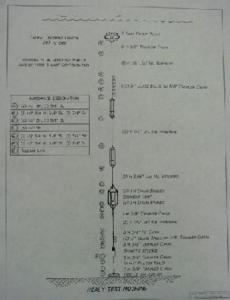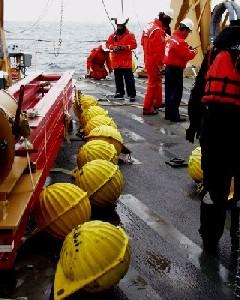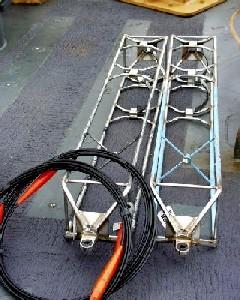11 June, 2000
11 June 2000
Mooring - Part I.
Today we are underway from Nuuk, Greenland to head for the ice. We need
to be in ice for part of the mooring testing, but the first part of the
testing will be done in open water along the way. A mooring is a string of
oceanographic testing/monitoring equipment anchored to the bottom of the
ocean and left there to collect data over a period of time. John Kemp and
Jeff Lord from the Woods Hole Oceanographic Institute are here to deploy the
mooring. Both of these men travel around the world setting up moorings for
various researchers. They design and assemble the moorings to collect
whatever type of data the researcher desires. The diagram that follows
illustrates one of many possible layouts for a mooring. The test mooring
is 200m long, but regular moorings may be over 4000m long. Regardless of
length, there are two primary ways to deploy (send off the ship) a mooring -
anchor-last and anchor-first.
Tomorrow’s open water deployment will be an anchor-last deployment. The
mooring is let out starting with the floats at the top and the rest of the
mooring is then slowly let out as the ship steams forward at about one knot.
When the end of the mooring is finally reached, the anchor to the mooring is
released off the ship. The anchor will then sink to the bottom dragging the
rest of the mooring with it. Now, if you are trying to picture this, you
have probably imagined one of the challenges with this type of deployment.
It is like a bombing run! You start away from your target (the place you
want the mooring anchored) and then sail up to it hoping you are at the
right spot when you drop the anchor. You also have the potential problem of
currents causing the payload you just dropped to miss its target. That is
one reason why trained mooring people like John and Jeff are very valuable
to an organization.
You might wonder how the data that is collected by the mooring is recovered.
The data contained in sediment traps, current meters, or instruments
measuring salinity and temperature has to be extracted from those
instruments at the surface. Researchers use a transponder system near the
anchor to tell the mooring when to release the equipment above the anchor.
The system uses sound signals from a unit controlled by John up on the ship
to trigger the release mechanism near the bottom of the ocean. Once
released, the glass floats and the large bubbles on top cause the rest of
the mooring to float to the surface where it is recovered. One of the first
things that will be done tomorrow is to test the transponder system to make
sure it is working properly. I’ll let you know how the anchor-last mooring
went tomorrow and then fill you in on how the anchor-first deployment works.
Note: Scanner is down, so diagram of mooring will come later. Jay

Jeff Lord brings out the sediment trap from storage - find it on the diagram of the mooring.

This is the diagram of John and Jeff's test mooring.

This string of floats is attached midway through the mooring to help with flotation.

Here are the floats at the top of the mooring that will carry it to the surface when detached from the anchor.

These are the housings that hold instruments for water measurements - find them in the diagram below.
Contact the TEA in the field at
.
If you cannot connect through your browser, copy the
TEA's e-mail address in the "To:" line of
your favorite e-mail package.
|
